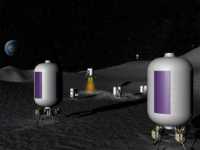New technologies using the electromagnetic spectrum show promise for better, more effective weapons to defend America – but only if the government provides the funding and support.
From Space.Com:
E-Weapons: Directed Energy Warfare In The 21st Century
 LOS ALAMOS, New Mexico — There is a new breed of weaponry fast approaching—and at the speed of light no less. They are labeled “directed-energy weapons” and may well signal a revolution in military hardware—perhaps more so than the atomic bomb.
LOS ALAMOS, New Mexico — There is a new breed of weaponry fast approaching—and at the speed of light no less. They are labeled “directed-energy weapons” and may well signal a revolution in military hardware—perhaps more so than the atomic bomb.
Directed-energy weapons take the form of lasers, high-powered microwaves, and particle beams. Their adoption for ground, air, sea, and space warfare depends not only on using the electromagnetic spectrum, but also upon favorable political and budgetary wavelengths too.
That’s the outlook of J. Douglas Beason, author of the recently published book: The E-Bomb: How America’s New Directed Energy Weapons Will Change the Way Wars Will Be Fought in the Future (Da Capo Press, October 2005).Beason previously served on the White House staff working for the President’s Science Advisor (Office of Science and Technology Policy) under both the Bush and Clinton Administrations.
This concept particularly intrigued me in that it also has potential in the area of law enforcement. Think of applications where a taser might be used, or in a hostage or standoff situation:
Then there’s Active Denial Technology—a non-lethal way to use millimeter-wave electromagnetic energy to stop, deter, and turn back an advancing adversary. This technology, supported by the U.S. Marines, uses a beam of millimeter waves to heat a foe’s skin, causing severe pain without damage, and making the adversary flee the scene.
Sizzle, you asshole!
And God forbid that advertisements or worse, Hip-Hop/Rap get delivered via this medium:
Beason said that one blue sky idea of his own he tagged “the voice from heaven”. By tuning the resonance of a laser onto the Earth’s ionosphere, you can create audible frequencies. Like some boom box in the sky, the laser-produced voice could bellow from above down to the target below: “Put down your weapons.”
The article concludes with the inevitable problem of bureaucracy holding technology back (emphasis added):
History lesson
Late last year, speaking before the Heritage Foundation in Washington, D.C., Beason told his audience that laser energy, the power sources, beam control, as well as knowledge about how laser beams interact with Earth’s atmosphere are quite mature. The technology is ready to shift into front line warfare status.
“The good news is that directed-energy exists. Directed-energy is being tested and within a few years directed-energy is going to be deployed upon the battlefield,” Beason reported. “But the bad news is that acquisition policies right now in this nation are one more gear toward evolutionary practices rather than revolutionary practices.”
“Visionaries win wars…and not bureaucrats. We’ve seen this through history,” Beason observed.
You can be assured that non-visionary bureaucrats (Ted Kennedys, Barbara Boxers and John Kerrys) will fight any new technologies tooth and nail.



 NASA’s Stardust sample return mission returned safely to Earth when the capsule carrying cometary and interstellar particles successfully touched down at 2:10 a.m. Pacific time (3:10 a.m. Mountain time) in the desert salt flats of the U.S. Air Force Utah Test and Training Range.
NASA’s Stardust sample return mission returned safely to Earth when the capsule carrying cometary and interstellar particles successfully touched down at 2:10 a.m. Pacific time (3:10 a.m. Mountain time) in the desert salt flats of the U.S. Air Force Utah Test and Training Range. LOS ALAMOS, New Mexico — There is a new breed of weaponry fast approaching—and at the speed of light no less. They are labeled “directed-energy weapons” and may well signal a revolution in military hardware—perhaps more so than the atomic bomb.
LOS ALAMOS, New Mexico — There is a new breed of weaponry fast approaching—and at the speed of light no less. They are labeled “directed-energy weapons” and may well signal a revolution in military hardware—perhaps more so than the atomic bomb.
 10 YEARS OF SOHO: Where would we be without SOHO? The orbiting Solar and Heliospheric Observatory (SOHO) keeps a ’round-the-clock eye on the sun and is crucial to space weather forecasting. Thousands of our readers have witnessed auroras only because SOHO spotted an incoming CME [coronal mass ejection] in time for us to issue an alert.
10 YEARS OF SOHO: Where would we be without SOHO? The orbiting Solar and Heliospheric Observatory (SOHO) keeps a ’round-the-clock eye on the sun and is crucial to space weather forecasting. Thousands of our readers have witnessed auroras only because SOHO spotted an incoming CME [coronal mass ejection] in time for us to issue an alert. Artist rendition of the “rocket chair,” designed to lower people and equipment onto the lunar surface. credit: Spacedev
Artist rendition of the “rocket chair,” designed to lower people and equipment onto the lunar surface. credit: Spacedev Unfortunately, the radiation that pervades space can trigger such glitches. When high-speed particles, such as cosmic rays, collide with the microscopic circuitry of computer chips, they can cause chips to make errors. If those errors send the spacecraft flying off in the wrong direction or disrupt the life-support system, it could be bad news.
Unfortunately, the radiation that pervades space can trigger such glitches. When high-speed particles, such as cosmic rays, collide with the microscopic circuitry of computer chips, they can cause chips to make errors. If those errors send the spacecraft flying off in the wrong direction or disrupt the life-support system, it could be bad news.